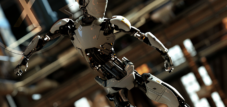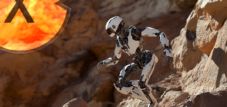Published on: March 31, 2025 / update from: March 31, 2025 - Author: Konrad Wolfenstein

The humanoid robot ”Ami” of the DLR_School_lab from Cottbus enters the stage: a German premiere-Image: BTU Cottbus-Senftenberg, Sascha Thor
Future up close: Humanoid robots as a new partner of humans
Humanoid robots conquer Germany: A new era of human-machine interaction begins in Cottbus
The world of robotics is in a rapid change. Robots have long been no longer just a rigid, industrial arms that do monotonous tasks. Rather, humanoid robots, i.e. robots in a human -like form, are becoming more and more focused on research and development. This development is not only fascinating, but also has enormous potential for a wide range of applications in industry, service, education and even in the private sector.
Suitable for:
- Angelina Jolie? The humanoid robot Ameca, the person and machine connects - from trade fairs to museums he conquers the world
The German Aerospace Center (DLR) and the DLR_School_lab as a pioneer
Germany plays an important role in this global race for the most advanced robot technology. The German Aerospace Center (DLR), one of the leading research institutions in the country, occupies a key position here. The DLR researches intensively on robots that can not only perform complex tasks, but can also interact with people safely and intuitively - so -called collaborative robots or cobots.
However, the integration of robots into our daily life also raises questions: How must robots be designed so that they are accepted by humans and perceived as helpful tools? How can we ensure that the cooperation between man and machine works smoothly and safely? These questions are of central importance for the research of the DLR in the area of robotics.
The dlr_school_lab itself is a student laboratory from the German Aerospace Center (DLR). It offers children and adolescents the opportunity to discover the world of research and technology by carrying out experiments that have a direct connection to current research projects from the fields of aerospace, energy, transport and digitization.
Suitable for:
- The AI-controlled robotics and humanoid robots: hype or reality? A critical analysis of the market maturity
“Ami” enters the stage: a premiere in Germany in Cottbus
Against this background, the German premiere of the humanoid robot “Ami” in the DLR_School_Lab in Cottbus became particularly important. This event was not only a presentation of the latest technology, but also an important step to sensitize the general public for the topic of robotics and to inspire young people in particular for a career in the MINT areas (mathematics, computer science, natural sciences and technology).
The dlr_school_lab: a bridge between research and education
The DLR_School_Lab in Cottbus is a special facility that serves as an interface between the research of the DLR and education. Here, pupils can independently carry out experiments, explore scientific concepts and gain exciting insights into the world of research. The experiments are closely based on the research focuses of the DLR in Cottbus and the scientific orientations of the Brandenburg University of Cottbus-Senftenberg (BTU) .
The premiere: a look into the future of robotics
The exclusive opening event under the motto “Experience the future-Humanoid robot and smart robot dogs in action / education meets the future” took place on March 27, 2025 in the DLR_School_lab on the central campus of the BTU Cottbus-Senftenberg. Media representatives and headmaster were invited to get to know the BTU College's new robotics program.
The aim of the program is to inspire young people at an early stage for robotics and artificial intelligence (AI) and to prepare them for the challenges and opportunities of the digital future. With the targeted address of the media and school leaders, DLR and BTU wanted to ensure that the information about the new program reaches a general public and are well received in schools.
“Ami” in detail: a communication talent with social competence
The focus of the event was the humanoid robot “Ami”. What distinguishes “Ami” from other robots is his ability to recognize and react to human facial expressions and gestures. This ability makes him a real “communication talent” and opens up new opportunities in human-machine interaction.
The interaction with “Ami” is described as natural and intuitive. Pupils who interacted with him reported that the robot is able to react context -related, accept different personalities and show different facial expressions. These observations indicate that “Ami” has a highly developed AI that enables him to adapt to different situations and to deal with the emotional signals of his counterpart.
The embodied KI: “Ami” as an ambassador for a new technology
The ability of “Ami” to recognize and react to human signals is based on the research field of embodied artificial intelligence (Embodied AI). This concept assumes that AI systems need a physical presence to really understand the world around it and to be able to interact with it.
In the DLR_School_LAB, pupils have the opportunity to work with humanoid robots such as “Ami” as part of the new experimentation offer “embodied artificial intelligence” and to research the principles of this technology. You will learn how AI systems are integrated into physical bodies and how these bodies interact with the environment via sensors and actuators.
The role of the AI: the robot's brain
Artificial intelligence plays a crucial role in the development of humanoid robots. It enables robots to master complex tasks, learn quickly and work with high concentration. Advanced AI systems combine visual perception, understanding of language and precise engine control, which means that robots are able to perform tasks for which they have not been trained before.
Companies such as Figure Ai, Ubtech Robotics, Nvidia and Tesla massively invest in the development of AI-based robots. Your vision is to create robots that are able to take on human -like tasks, be it in industry, in the service sector or in private household.
“Ami” in comparison: What makes it special?
The DLR has an impressive collection of humanoid robots, each specializing in different research areas. “Agile Justin”, for example, is a research platform for learning artificial intelligence for sensitive manipulation and is used in particular for household work and the support of astronauts in space. “David” is an anthropomorphic robot with joints whose stiffness is mechanically adjustable, with the aim of achieving human skills in terms of dynamics, skill and robustness. “Rollin 'Justin” is a mobile humanoid robot that serves as a research platform for autonomous, skillful mobile manipulation in human environments and in space and is able to catch balls, cook coffee and repair satellites. “Toro” is a research platform for scientific topics in the field of two -legged locomotion and dynamics, including robust walking and climbing stairs. “Spacejustin” was a humanoid upper body construction for telemanipulation and shared autonomy modes.
Compared to these robots, “Ami” seems to have a different focus. While the other robots of the DLR are more like complex manipulation and locomotion tasks, “AMI” focuses on social interaction and communication with people. This is reflected in its ability to recognize and react to human facial expressions and gestures.
However, there are other humanoid robots that have similar skills. The robot “Ameca” by Engineered Arts, for example, is known for its lifelike facial expressions. The (other) robot “Ami”, which was developed by the Kaist (Korea Advanced Institute of Science and Technology), focuses on service applications in the household, basic conversation and displaying emotions.
Suitable for:
- Humanoids, industrial and service robots on the upswing- humanoid robots are no longer a science fiction
The vision of the DLR: “Ami” as an ambassador for the MINT professions
The main goal of the DLR at the presentation of “Ami” in the DLR_School_lab is to inspire young people for the MINT professions and prepare them for the digital future. With “Ami”, the DLR wants to awaken the interest of students in science and technology and encourage them to take appropriate studies and professions.
A special feature of the program in the DLR_School_lab is the aspect of the “Hands-on Research” (practical research). Students have the opportunity to interact with “Ami”, to experiment and to explore their functions and the underlying AI. This practical experience should help you develop a deeper understanding of the technology and to arouse your enthusiasm for the MINT areas.
Even if “Americans” do not directly match the primary research areas of aviation and energy in Cottbus, his role in the DLR_School_lab serves a broader purpose: the introduction of basic concepts of AI and robotics. These concepts are increasingly relevant for various scientific and technical disciplines, including those who focus on sustainability and advanced technologies. By evoking interest in these basic areas, the DLR hopes to win future researchers and engineers who may one day contribute to their specific fields.
Visual insights: “Ami” in action
The opening event on March 27, 2025 offered the opportunity to take film and photo recordings of “Ami”. These visual documentation are invaluable to give an impression of “Americans” appearance and its skills.
“Ami” is a bust or a humanoid upper body, the design of which was specifically geared towards facial expressions and interaction. His ability to react to facial expressions and gestures is similar to other expressive humanoid robots like “Ameca”, which are known for their lifelike facial expressions. ”
The ethical implications: a responsible development
The development of humanoid robots like “Ami” also raises ethical questions. How can we ensure that these robots are used for the good of humanity and not to harm? How can we prevent them from being used for surveillance purposes or manipulation of people?
It is crucial that the development and use of humanoid robots are based on ethical principles and that the privacy and autonomy of the individual are protected. An open and transparent discussion about the ethical implications of robotics is essential to ensure that this technology is used responsibly.
The future of humanoid robotics: a vision for the future
The development of humanoid robots is still at the beginning, but the potential of this technology is enormous. In the future, humanoid robots could be used in a variety of areas, from the care of older people to the support of people with disabilities to research into space.
The progress in artificial intelligence, robotics and materials science will make it possible to develop increasingly powerful and versatile humanoid robots. These robots will be able to carry out complex tasks, to interact with people naturally and to adapt to different environments.
“Ami” inspires young talents for science and research
The Germany premiere of the humanoid robot “Ami” in the DLR_School_Lab in Cottbus is a promising step into the future of robotics. “Ami” is not only an impressive example of the progress in human-machine communication, but also an ambassador for the MINT professions and a tool to inspire young people for science and technology.
The development of humanoid robots has enormous potential for the future, but it is important that this technology is developed and used in a responsible and ethical manner. This is the only way we can ensure that humanoid robots contribute to the good of humanity and improve our quality of life. The work of the DLR and other research institutions in this area is of crucial importance to realize this vision.
Suitable for:
Your global marketing and business development partner
☑️ Our business language is English or German
☑️ NEW: Correspondence in your national language!
I would be happy to serve you and my team as a personal advisor.
You can contact me by filling out the contact form or simply call me on +49 89 89 674 804 (Munich) . My email address is: wolfenstein ∂ xpert.digital
I'm looking forward to our joint project.














